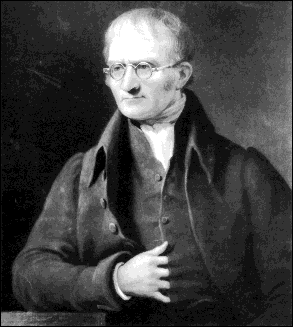1902 Encyclopedia > Chemistry > History of Chemistry: John Dalton
HISTORY OF CHEMISTRY: John Dalton (1766-1844)
In August 1804, Dalton (1766-1844) communicated to Dr Thomson his theory of the atomic composition of bodies. Dalton’s ideas had been vaguely foreshadowed by W. Higgins of Pembroke College, Oxford, in a publication entitled A Comparative View of the Phlogistic and Antiphlogistic Theories, where we read that –
"In volatile vitriolic acid a single ultimate particle of sulphur is intimately united only to a single particle of dephlogisticated air; and in perfect vitriolic acid every particle of sulphur is united to two of dephlogisticated air, being the quantity necessary to saturation. As two cubic inches of light inflammable air require but one of dephlogisticated air to condense them, we must suppose that they contain equal number of divisions, and that the difference of their specific gravity depends chiefly on the size of their ultimate particles; or we must suppose that the ultimate particles of light inflammable air require two or three or more of dephlogisticated air to saturate them. If this latter were the case, we might produce water in an intermediate state, as well a the vitriolic or the nitrous acid, which appears to be impossible; for in whatever proportion we mix our acids, or under whatever circumstance we combine them, the result is invariably the same." – (2d ed., 1791.)

John Dalton (1766-1844)
English chemist who proposed the theory of atoms
which he considered to be the smallest constituents of matter
The atomic theory first suggested itself to Dalton during his investigation on marsh-gas, or light carburetted hydrogen, and olefiant gas. He calculated that if the weight of carbon in each of these compounds were reckoned to be the same, then marsh-gas contained exactly twice the weight of hydrogen present in olefiant gas. He further observed that the quantity of oxygen in carbonic acid gas was twice as much as in carbonic oxide gas. These and similar facts he conceived might be explained by assuming the ultimate particles of matter to be incapable of further division, or, in other words, atoms, possessing definite weights, the ratios of which could be denoted by numbers, the weight of an atom of hydrogen being taken as unity. The combination of these atoms with one another would account then for the definite proportions in which the elements united. For clearness the atoms were represented by symbols, thus: --
TABLE
Binary compounds with their weights were denoted thus: --
TABLE
And ternary compounds in a similar manner: --
TABLE
The weight of the smallest particle of a compound was therefore, according to Dalton’s theory, to be obtained by adding together the weights of its constituent atoms; the laws discovered by Wenzel and Richter were thus included within the law of atomic weights.
The new theory was promulgated in Dr Thomson’s System of Chemistry, 3d edit., 1807. In the same year Thomson showed that the amount of oxalic acid required to form strontium binoxalate was twice as great as that in the case of the oxalate, supposing the weight of strontium in each salt to be the same; and Dr Wollaston proved that three potassium oxalates were obtainable, to form which a definite amount of potash needed weights of oxallic acid in the proportion of 1:2:4.
Read the rest of this article:
Chemistry - Table of Contents
|
